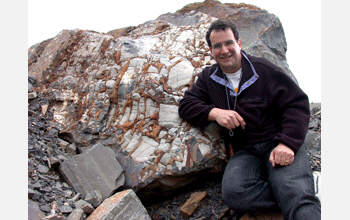Multimedia Gallery
Cause of Earth's Earliest Ice Age (Image 1)
Alan Jay Kaufman in front of a neoproterozoic collapse breccia in Argentina.
Kaufman was part of a collaboration of scientists who uncovered evidence that the oxygenation of Earth's atmosphere--generally known as the Great Oxygenation Event--coincided with the first widespread ice age on the planet.
The scientists used sulfuric isotopes to determine the oxygen content of ~2.3 billion year-old rocks in the Transvaal Supergroup in South Africa. In so doing, they found evidence of a sudden increase in atmospheric oxygen that broadly coincided with physical evidence of glacial debris, and geochemical evidence of a new world-order for the carbon cycle. "The sulfur isotope change we recorded coincided with the first known anomaly in the carbon cycle. This may have resulted from the diversification of photosynthetic life that produced the oxygen that changed the atmosphere," Kaufman said.
The collaboration included scientists from the University of Maryland, including postdoctoral fellows Boswell Wing and Sang-Tae Kim, graduate student Margaret Baker, and professors Alan J. Kaufman and James Farquhar, along with colleagues in Germany, South Africa, Canada and the United States. To learn more, see the University of Maryland news story, "Rise of Oxygen Caused Earth's Earliest Ice Age." [Research supported by National Science Foundation grants EAR 03-48382 and EAR 04-18005] (Date of Image: 2006-08) [See related image Here.]
Credit: Alan J. Kaufman
Images and other media in the National Science Foundation Multimedia Gallery are available for use in print and electronic material by NSF employees, members of the media, university staff, teachers and the general public. All media in the gallery are intended for personal, educational and nonprofit/non-commercial use only.
Images credited to the National Science Foundation, a federal agency, are in the public domain. The images were created by employees of the United States Government as part of their official duties or prepared by contractors as "works for hire" for NSF. You may freely use NSF-credited images and, at your discretion, credit NSF with a "Courtesy: National Science Foundation" notation.
Additional information about general usage can be found in Conditions.
Also Available:
Download the high-resolution JPG version of the image. (1.9 MB)
Use your mouse to right-click (Mac users may need to Ctrl-click) the link above and choose the option that will save the file or target to your computer.

